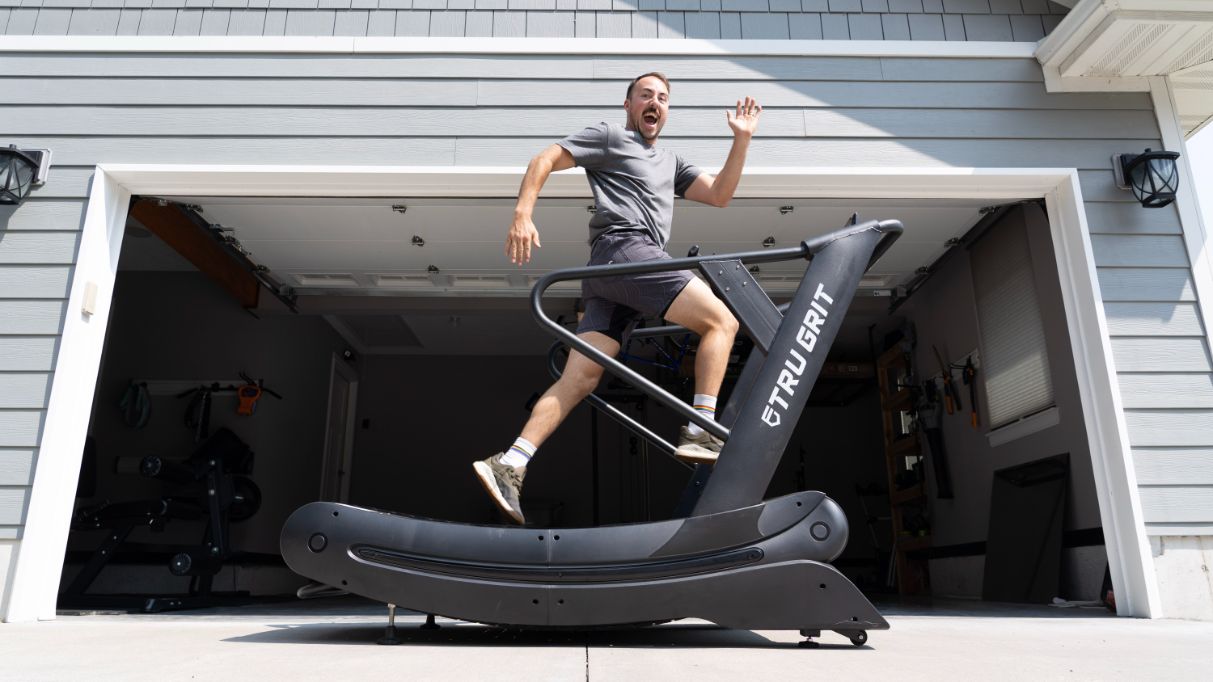We test and review fitness products based on an independent, multi-point methodology. If you use our links to purchase something, we may earn a commission. Read our disclosures.
Running is fantastic exercise: Gets your heart rate up, burns calories, and it can even elevate your mood. However, if you just go for a 30-minute jog every day, you may grow bored and even unenthusiastic, leading to excuses not to train. Worse, you may eventually stop advancing your fitness.
Like New York City bike messengers who work all day, you may become capable of incredible fitness feats, but your body begins to stagnate as it merely adapts to what you’re doing instead of being forced to make improvements. If you want to make real gains with your running, you’ve got to mix it up with something like treadmill speed training.
I am one of the maniacs out there who loves cardio. I’m constantly pushing for more burpees and faster sprints. However, with years of training, I have learned that there are ways to feel the stimulation and intensity of running a 10K without running a 10K. If you’re looking to add in speedwork, I have created four workouts to maximize your time and efforts.
Incline Workout
Incline workouts mimic the experience of walking or running up a mountain. According to one study in the National Library of Medicine, incorporating an incline in your treadmill routine burns more calories compared to walking on a flat surface. Incline straining also stimulates muscle growth in places like your glutes and hamstrings, and it has even been shown to be less stressful on your joints.
Whether outside or on a treadmill, when you walk or run up a hill, your body weight becomes something you must carry as it acts as a form of resistance. Therefore, an inclined treadmill forces your body to challenge itself and work harder, stimulating muscles more intensely while also challenging you to push yourself forward.
Try This:
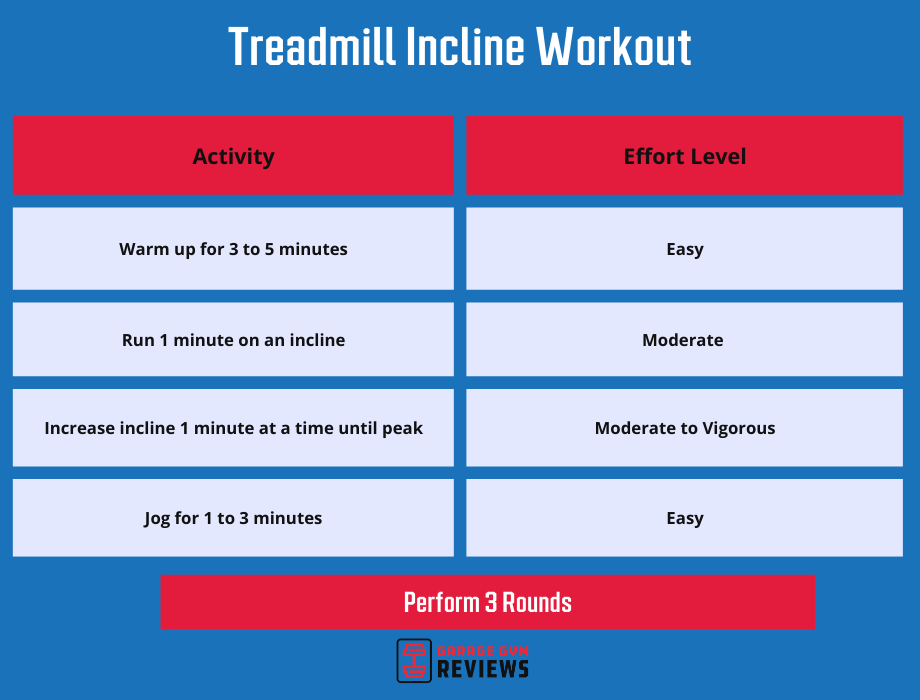
Incline Workout
3- to 5-minute warmup at 0% incline, then:
3 Rounds:
Run for 1 minute on an incline, increasing incline every minute until peak
1- to 3-minute jog at 0% incline
How to Do It:
- Start with a light walk or run to warm yourself up for 3 to 5 minutes.
- Begin to elevate your treadmill’s gradient gradually (this will vary based on your fitness level). Every time you raise the incline, run intensively for 1 minute. Continue to increase the gradient without a break until you feel you have reached your peak slope.
- Once getting to that maximum incline, drop the treadmill back down to its original position, and run or jog for 1 to 3 minutes.
- Repeat for several rounds.
Remember to maintain your running form and breathe as you adjust the monitor. I would suggest a minimum of three sets, always trying to push the incline steeper and steeper with every round.
Treadmill Interval Workout
Remember what I said about running a 10K without running a 10K? High-intensity interval training on a treadmill can do just that. It is an excellent choice for people short on time and a radically efficient way to train.
Like sprint workouts, interval training forces your muscles to demonstrate more explosive power. This leads to the rapid growth of muscle mass, as well as helps to increase your cardiovascular system’s ability to deliver oxygen promptly while training.
RELATED: HIIT Treadmill Workout
Try This:
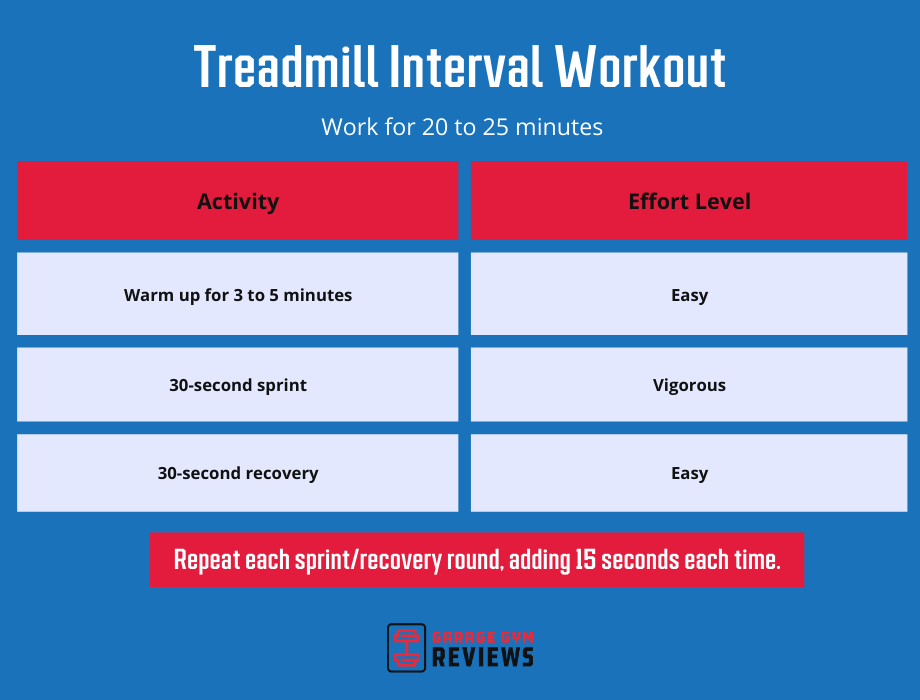
Treadmill Interval Workout:
3- to 5-minute warmup at 0% incline, then:
20-25 Minutes:
30-second sprint
30-second walking or jogging cool down
Continue by increasing each rep by 15 seconds
How to Do It:
- Warm up with a 3- to 5-minute walk or run.
- Set the speed to your hard sprint, and run for 30 seconds.
- Return to a comfortable walk or jog speed where you can catch your breath for 30 seconds.
- Repeat each round by increasing your time by 15 seconds.
Try to get your workout to a steady 30 minutes if you have the time or energy. Also, experiment with increasing your top speed if it feels safe to do so.
The times are also suggestions. You can cut your slow-down rounds while increasing your high-intensity rounds. This all depends on your comfort level. Furthermore, focus on using your slowed walk or run rounds to catch your breath. This helps to trick your body into thinking it is resting when it is not, a fantastic way to keep advancing your aerobic capacity.
Running Repeats
Running repeats is another way to challenge yourself in a short amount of time. What this means is that you pick a set distance and run it for several rounds, with rests like easy jogs or walks in between, with a target time for each run.
If you’re looking for endurance training, you may pick a longer distance, like an 800-meter or 1-mile repeat. If you want a higher intensity workout, choose shorter distances, like 200 or 400 meters. While you know your body can handle the distance, the challenge lies in forcing your body to more quickly tackle that distance.
Try This:
Treadmill Repeats Workout
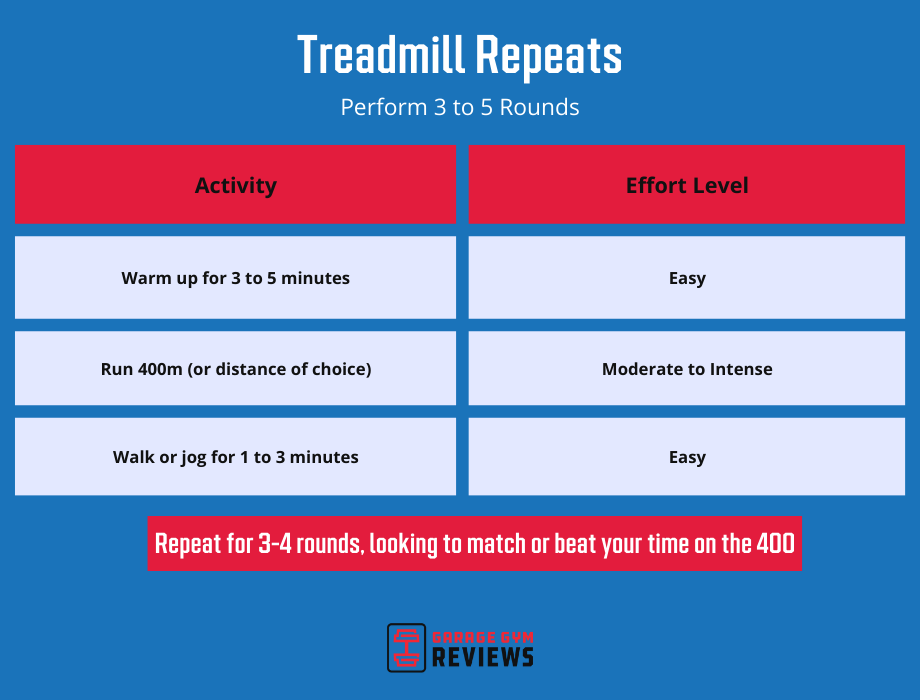
3 to 5 Rounds:
Run 400m (or your distance of choice) at a moderate-to-intense pace
Cool-down walk or jog for 1 to 3 minutes
Repeat 400m run, but aim to match or beat your prior time
How to Do it:
- Start by establishing a distance you are comfortable with. This could be a few hundred meters or a few miles.
- Push the pace on the run.
- Jog or walk for 1 to 3 minutes for rest, depending on your distance, fitness level, and ability to cool down.
- Repeat for 3 to 5 sets, aiming to match or beat your previous time.
(Hint: If you’re training for a marathon or half-marathon, check out a popular running workout called the Yasso 800s.)
Fartlek Workout
Fartlek literally means “speed play” in Swedish. So a Fartlek workout on your treadmill is pretty much just that: speed training made “fun.” When Fartlek training, you don’t stop moving, and you don’t have a full rest. With constantly moving, you are testing your body with various speed options.
The Fartlek helps challenge your cardio while also helping you discover new levels of speed you may have thought weren’t possible.
The workout may sound chaotic or unstructured as if you’re about to DJ a treadmill monitor. However, I have an excellent “speed play” routine for you to follow below that will help you to understand the Fartlek and try it out for yourself.
Try This:
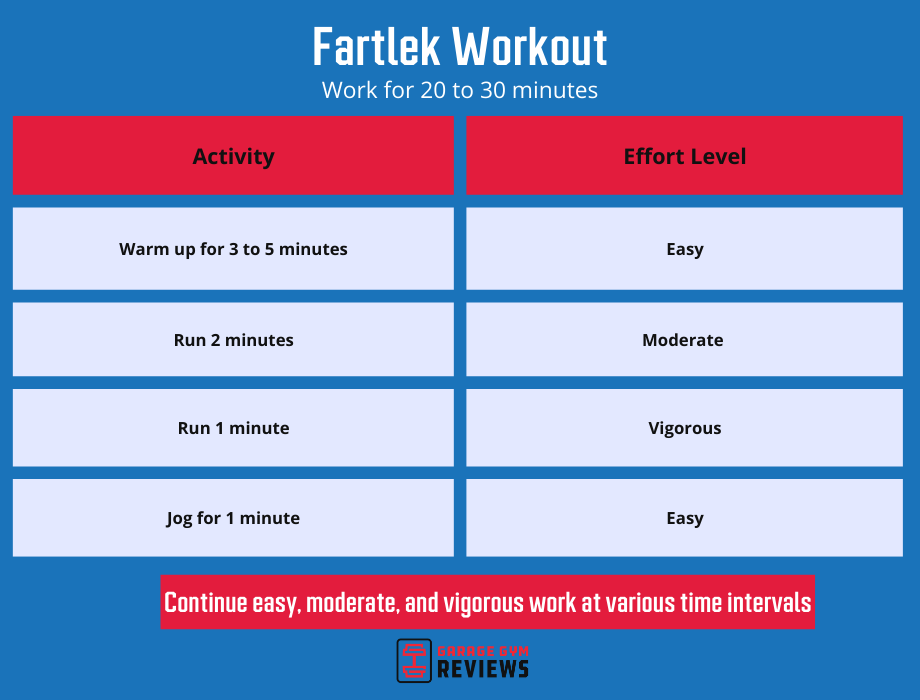
Fartlek Workout:
Go for 20 to 30 Minutes:
Run at an easy pace 3 to 5 minutes
Run at a medium pace 2 minutes
Run at a maximum effort 1 minute
Jog or walk for 1 minute
Run at a medium pace for 2 minutes
Run at maximum effort for 2 minutes
Continue by changing speed and time
How to Do It:
- Jog or run at an easy pace for 3 to 5 minutes.
- Run with medium effort for 2 minutes.
- Run hard for 1 minute.
- Walk for 1 minute.
- Run at medium effort for 2 minutes.
- Run hard for 2 minutes.
Repeat with various times and speeds. However, I suggest always using your maximum effort round to push your speed level higher (always with safety in mind). Continue as long as possible, but I would suggest aiming for a 30-minute workout or less.
Benefits of Running on a Treadmill
A treadmill gives you total control of your workout while having access to real-time data regarding your achievements. Here are a few key benefits to running on a treadmill:
Safety
Running outside is great. However, outdoor terrain can be unpredictable. Also, running on unstable or uneven surfaces can lead to inflammation or injury (sprained ankles and stressed knees, just to name a few). A treadmill’s flat and predictable surface creates some of the safest circumstances for running while preserving your knees and overall joint health.
If you’re running on a treadmill at home, you have control over the environment you’re in. If you’re running on the streets, you may be subject to traffic and unwelcome company.
No Weather Concerns
This is an obvious benefit. Whether it’s pouring rain, snowing, or simply too hot outside, none of this applies to you running on a treadmill. Additionally, this limits your excuses not to train!
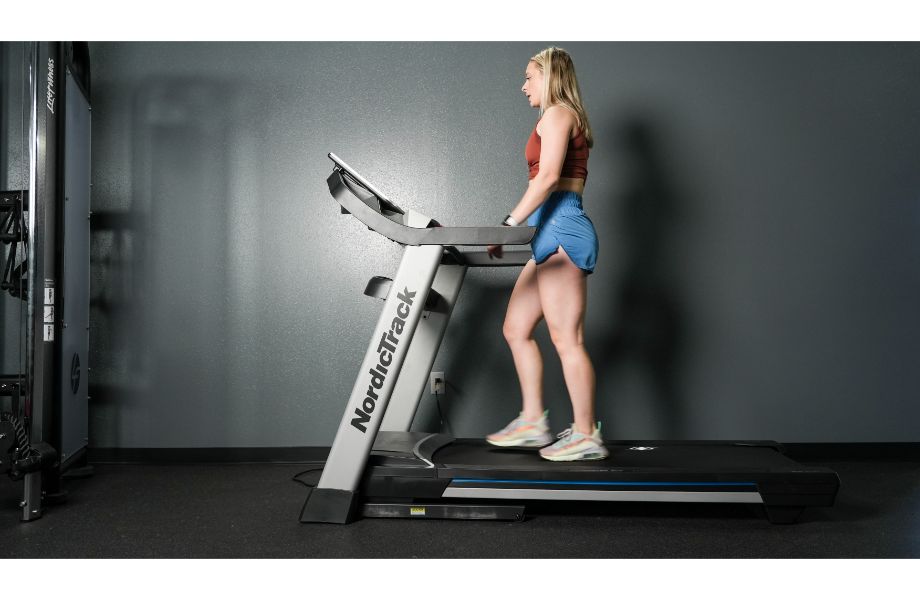
Speed and Incline Adjustments
You don’t need actual mountains to feel like you’re running on mountains when you own a treadmill. And while sometimes you may think you’re pushing yourself, you may just be stagnating. A treadmill allows you to test your ability to climb inclines and understand the specific elevation you are taking on as you do.
Additionally, a treadmill allows you to control and understand your speeds accurately. This accuracy in reporting your overall performance helps you to draw precise conclusions and better understand your current fitness level and when you level up.
What Pace Should I Use For Treadmill Speed Training?
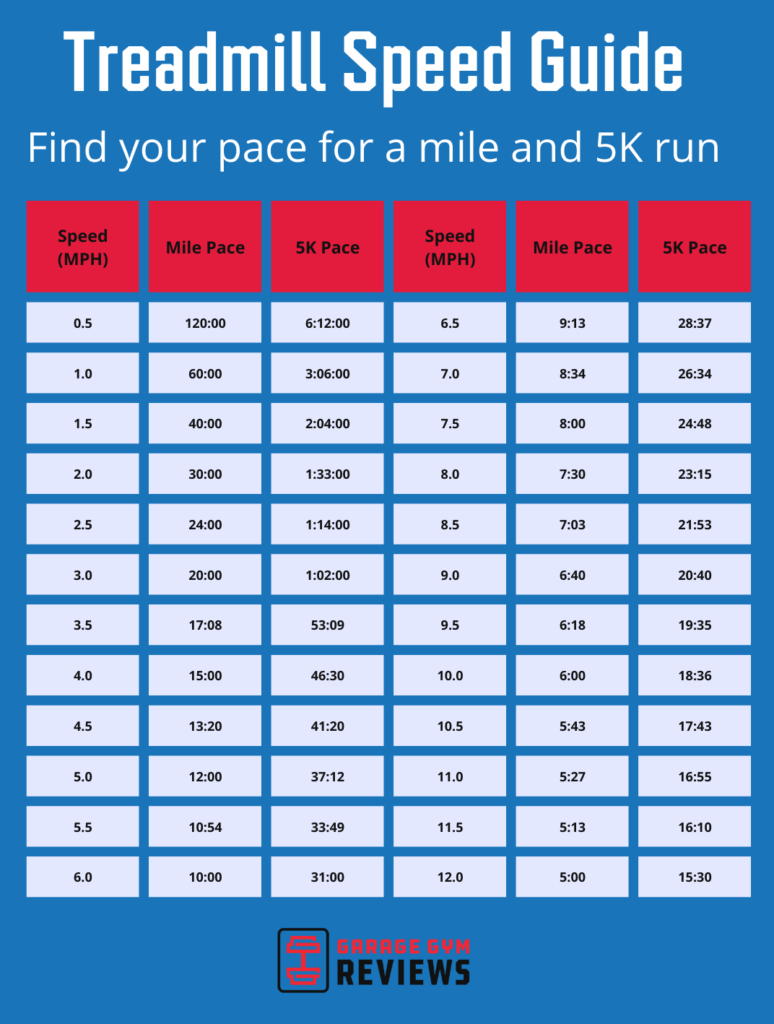
In treadmill speed training, you are always looking to push yourself further in a shorter period of time. How your routine looks though, depends on your current fitness level and goals.
From personal experience, I would suggest beginners consider experimenting with 2 to 7 MPH, with 2.0 for easy paces and 7.0 being top speeds. More intermediate or advanced runners try 5 MPH for easy paces to 11 MPH max speeds. Make note of the pace you’re using, and each week or every two weeks, push yourself to try to go even one-tenth of a mile faster.
Final Thoughts
These workouts allow for the diversification of your treadmill training. I suggest trying them all. Pick the most exciting one that prevents excuses and keeps you returning for your workout. If you max out or get bored, try another routine or consider pushing your current one further.
These routines, especially interval training and running repeats, can be incorporated into a broader workout routine that includes breaks for additional cardio or strength training alongside your treadmill. While these are all guidelines, it’s essential to constantly diversify and get creative to prevent boredom, burn out or physical stagnation.
Finally, the goal is always to push further, but it’s essential to understand where you stand now. So please, start from a safe place, and work from there. If you’re starting from scratch, don’t get frustrated. Regardless of where you stand, always remember that growth is the goal, and the secret is to begin.
Treadmill Speed Training FAQs
Are treadmills good for speed training?
Treadmills are perfect for speed training. When we run outside, maybe we are excited by a song or pushed by the wind and assume we are breaking barriers and achieving new goals. However, despite what we may think, genuinely understanding our speed, incline and the actual numbers behind our training is not really possible without the help of technologies such as a treadmill.
Furthermore, running can be dangerous. If done incorrectly, it can be harmful to your knees and cause damage to your joints.
Treadmills help you master a safe and healthy running technique by offering an even and predictable surface to train on. Rounding corners, passing pedestrians and running over broken sidewalks not only add risk to your run, but they do not allow for the safe acceleration of your body and steady increase of your routine.
On a treadmill, you can know the precise numbers of your accomplishments and have a safe place to push yourself further. Running is beautiful, as you can do it anywhere and with little equipment. Additionally, it is one of the most efficient exercises for weight loss. However, owning a treadmill gives you a significant and safer advantage over outdoor runners in challenging yourself and achieving your fitness goals.
How fast is 7.0 on a treadmill?
Seven MPH on a treadmill will give you an 8:34-mile time. For distance running, this is a quality intermediate pace. However, for speed training, I would look to go over 7 MPH for intense rounds and under when catching your breath.
What is a good treadmill running speed?
A good treadmill running speed depends on your experience and the type of workout you are doing. I would start with 3 to 5 MPH on a treadmill for beginners or out-of-shape runners looking to do distance runs rather than speed training. For intermediate and advanced runners, I suggest 6 to 9 mph for longer distance training.
It’s best to get on the treadmill and see where you stand. Push yourself, but there is no point in starting by burning yourself out. Instead, find a speed where you are comfortable and increase it to one you are less comfortable with but can manage. Continue this experience-based approach in long-term distance training or treadmill speed training routines.
Further reading

A fitness expert describes how to do the 13 best posterior chain exercises, explains their benefits, and gives 3 sample posterior chain workouts to try. Read more

Starting a home gym on a budget may seem impossible, but it's not. Not even close. We've compiled 10 of our most important tips that we've given out over the years on how to build a home gym on the cheap. Time to get started! Read more

Are your ankles or knees achy after running? Check out our top picks for the best shock-absorbing treadmills you find on the market. Read more

Running is fantastic exercise: Gets your heart rate up, burns calories, and it can even elevate your mood. However, if you just go for a 30-minute jog every day, you may grow bored and even unenthusiastic, leading to excuses not to train. Worse, you may eventually stop advancing your fitness.Like New York City bike messengers who work all day, you may become capable of incredible fitness feats, but your body begins to stagnate as it merely adapts to what you’re doing instead of being forced to make improvements. » Read more about: 4 Treadmill Speed Training Workouts to Get Faster and Improve Fitness » Read more

